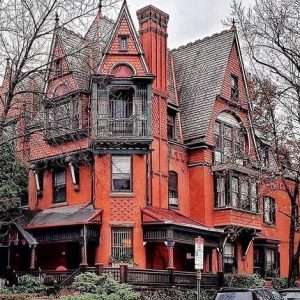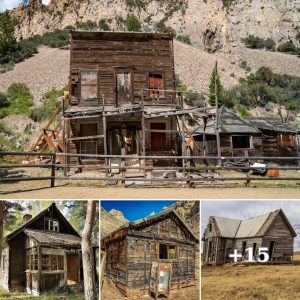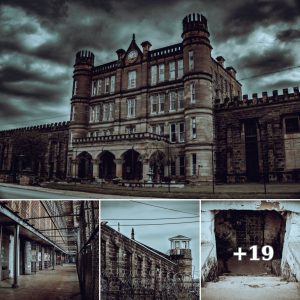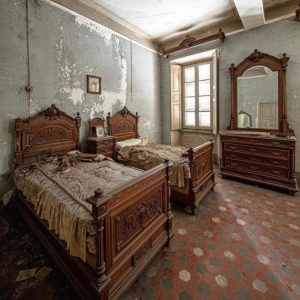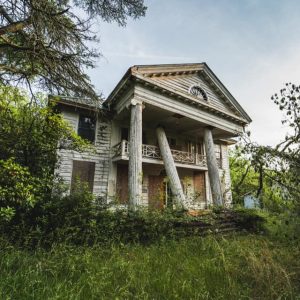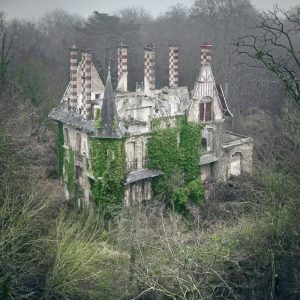
Central State Hospital | Milledgeville, Baldwin County, Georgia | Founded c. 1837
This campus was once the largest facility in the United States for the treatment of mental illness. Eventually, advancements in medical care, changing ideals, and damaging allegations and rumors forced the closure of the hospital. Today most of the buildings sit empty, but an effort to revitalize the campus is underway that hopes to preserve the history that remains in an innovative way.
The Largest Asylum in the United States
In the mid-1800s, the state authorized a “lunatic, idiot, and epileptic asylum” to be built near the capital. Originally chartered in 1837, Central State Hospital opened on 57.5 acres in 1842 as the state’s largest psychiatric hospital. At the time, it was also the nation’s largest psychiatric hospital and the second largest in the world. Over the next 100 years, it would go on to become the largest insane asylum in the world, with 13,000 patients, and 200+ buildings, set over 2,000 acres. Central State operated as an independent community to accommodate its patients and employees, including an on-campus farm, and police and fire departments.
Central State Hospital During the Civil War
Central State stayed open during and after the Civil War and even housed veterans who were left without homes. In 1861, General William T. Sherman and 30,000 Union troops marched into Milledgeville during their “March to the Sea.” While much of the community of Milledgeville was destroyed, Central State Hospital was spared from destruction and continued to expand into the 20th century.

Central State reached its highest occupancy during the 1960s with 12,000 patients and at that time, it was a completely self-sufficient campus that included the world’s largest kitchen, laundry facilities, a large medical-surgical hospital, farms, and meat-processing facilities.

Central State worked on a ‘family model’ of care that emphasized creating a comfortable atmosphere throughout the hospital. The staff worked to the best of their abilities, but conditions grew more crowded and difficult and then, CSH earned a reputation that it wouldn’t be able to shake.
“I’ll Ship You Off To Milledgeville!”
The institution had a reputation that spread across the state and you can ask a generation of Georgians what they think of when they hear Milledgeville. They’ll all recall for you how their parents levied the threat of ‘being shipped off to Milledgeville’ (or some variation) anytime they were ill-behaved. The far-reaching rumors about how scary Milledgeville was likely had more to do with the lack of understanding about the medical conditions that were treated here, but over time, the rumors took hold and became a part of the facility’s reputation.
1960-Today
Stories of alleged neglect and mistreatment began to circulate about the hospital and in 1959, an investigation showed that the conditions in the asylum weren’t up to an acceptable standard. A portion of the report even alleged that some of the medical staff were actually previous patients themselves, who were hired as soon as they were released.
Over the next few decades, advances in psychiatric medications, a movement to deinstitutionalize, and the negative press about the facility began the gradual decline of the asylum. As patient numbers declined, many of the buildings fell out of use and into disrepair. Other regional psychiatric hospitals opened and advancements came about that allowed other patients to be treated at home. By the 1970s, many of the 200 buildings Central State campus were boarded up. In 2010, the hospital stopped accepting new patients, and today, the Department of Behavioral Health & Disabilities occupies 9 buildings and another 30 are still in use for various purposes across 1,750 acres.

All of the buildings on the Central State campus are private property and are not accessible to the public. The grounds are monitored by security guards and you will be prosecuted if you try to go inside these buildings. They are unsafe and you should not trespass here!
A Future For Central State Hospital?
Of the buildings that have been shuttered, they sit in various states of repair, some of which might never be brought back to life. But in the past decade, a group of interested individuals gathered to try and find an effective new purpose for the historic site, Central State Hospital Redevelopment Authority, CSHLRA. In early 2019, the CSHLRA established a new identity for the campus to emphasize its goal to reinvent, re-imagine and revitalize the space. They currently have more than 70 listings available on their website that are ready to be renovated and developed. You can see them here.
According to their website: the name “Renaissance Park was chosen, in part, because of its symbolism of rebirth. We are excited about the opportunities that lie ahead for this important redevelopment effort, and we’ll continue to pursue projects and partnerships that benefit our community. Today, more than 20 private partners are on Campus and have purchased their property, constructed new facilities, or are investing large sums of capital investment in upcoming projects. Our primary mission is to create jobs and improve the surrounding community.”
Once monthly trolley tours of the campus are offered and can be booked HERE.
The Cemeteries of Central State Hospital
Over 170 years of medical treatment, many patients died and were buried on the grounds, either by request or because families did not claim them. Three cemeteries are the final resting place of about 25,000 people. None of the graves had markers, but recently, efforts have been made to install simple markers at each burial. Efforts began at Cemetery #1 and will hopefully continue across the other cemeteries in time.


The Jones Building was named in honor of Dr. Lodrick M. Jones, a graduate of the Atlanta Medical College in 1878. Dr. Jones served as superintendent for Central State Hospital from 1907 until his death at the age of 72. The Jones Building was erected in 1928-29 and was used as a general medical-surgical hospital. At that time, it was the only hospital in Milledgeville. Both employees and patients, as well as people in the community, gave birth to their children at the hospital.
The building was equipped with modern operating rooms and wards for medical and surgical cases, and it also housed the hospital’s clinical laboratory, x-ray department, out-patient clinic, and morgue. Throughout the building’s operation, many medical problems were treated from common colds to sophisticated surgery. After five decades of continued use, the building was finally closed in 1979.
The Walker Building, c. 1884

Construction on the Walker Building began in 1884 and was completed in 1886. It was originally known as the Male Convalescent Building. It served as the admission ward for white males and was continuously used to treat patients until it closed in 1974.
This 40,000-square-foot building is showing the most damage of all the campus buildings. After years of disuse, the ceiling on the third floor has fallen in, and now, it is home to small mammals, snakes, and insects. The walls contain mold, peeling paint, algae, and hazardous materials. The foliage that has grown over large portions of the exterior of the building is causing additional damage to the brickwork and foundation.

The Green Building

The Green Building was used for 30 years from 1947 until 19xx. It was used to house white convalescent patients who suffered from conditions such as schizophrenia. These patients were likely to never leave.
The building was named in honor of Dr. Thomas F. Green who was appointed superintendent of the Georgia Lunatic Asylum in 1845. Under Superintendent Green, hospital staff treated numerous Civil War veterans suffering from the effects of battle after the war ended in 1865. Dr. Green worked for 33 years before collapsing on the job while caring for a patient. He died two days later in February 1879.
In the late 1970s and early 1980s, it was re-opened and given to Baldwin County. It was last used by the Department of Children and Family Services, Head Start, and for gifted students and adult literacy.
